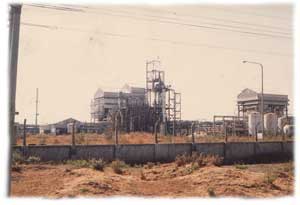
|
Toxics Present, Toxics Future

January, 2002: Srishti released, on January 12, 2002, a report entitled Surviving Bhopal, Toxics Present - Toxics Future, as part of the ongoing Bhopal Fact Finding Mission. The report is a study on the environmental contamination around the vicinity of the Bhopal disaster site, and a contextual analysis of the environmental policy and legislative response of the Indian State. The Fact Finding Mission on Bhopal was set up in 1999 as a multidisciplinary investigation on the current status of various aspects of the Bhopal tragedy and its ongoing impacts. Srishti carried out the environmental study. While Dr. Amit Nair did the environmental contamination survey, Ravi Agarwal carried out the coordination and policy analysis. It is a first study of its kind, which examines both the migration of chemicals from the natural environment to the human body, as well as the inadequate environmental response to the Bhopal disaster. Results of the survey clearly indicate mobility of the toxic chemicals from the emanating source, the UCIL factory to the adjoining residential areas. Further there are no other chemical industries within the radius of 3-5 km from the factory, which have used the chemicals mentioned in UCIL inventory. The study indicated contamination of breast milk as well as soil, water and vegetables by HCH, VOCs as well as mercury, lead and nickel. It gives rise to possibilities of inter-generational effects being transferred to the next generation of the survivors who are themselves coping with health effects suffered from he exposure over fifteen years ago. The samples from the residential areas showed all the toxic chemicals present in the factory and its acquired premises. Among the toxic chemicals analysed in the soil, 56% constituted chloroform, 14% HCH isomers, 8% VOC's and 20% heavy metals. Among the heavy metals nickel constitutes 9%, while mercury and chromium amounted to 5 and 6%, respectively. The groundwater samples showed the highest concentration of dichloromethane, which amounted to 44% of the total toxic chemicals. The water also contained 23% chloroform and 30% nickel. In the vegetable samples, 77% comprised chloroform, while 20% constituted heavy metals. Mercury accounted to 9% while nickel and chromium amounted to 5 and 6%, respectively. The major contaminant in the breast milk was VOC's, which accounted to 40% of the total toxic chemicals detected. The pesticide, HCH formed 34% of the total toxicants, while chloroform constituted 16% of the contamination. The report also analyses the inadequacy of the State to prevent such disasters even today despite having a battery of laws. While many other countries including the USA set up a very strong Right to Know legislation and Toxics Release Inventories, Indian communities are still at sea about toxic releases. The report analyses the findings of the MGK Menon Committee, and it damning indictment of the hazardous waste situation in India as a case study. The Fact Finding Mission and Srishti are demanding a Clean up of the Site as well as immediate release of all environmental and human health data linked besides a community Right to Know legislation. Toxics Link Delhi
H-2 Jungpura Extention
New Delhi 110 014
Tel: 4328006/4320711
Fax: 4321747
e-mail: tldelhi@vsnl.com